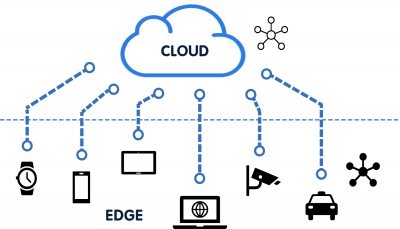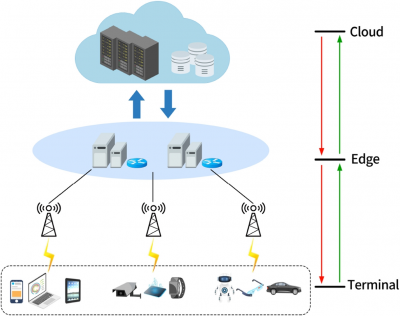Machine Learning at the Edge: Difference between revisions
| Line 73: | Line 73: | ||
[https://www.mdpi.com/2079-9292/13/3/640 6. Grzesik, Piotr, and Dariusz Mrozek. "Combining machine learning and edge computing: Opportunities, challenges, platforms, frameworks, and use cases." Electronics 13.3 (2024): 640.] | [https://www.mdpi.com/2079-9292/13/3/640 6. Grzesik, Piotr, and Dariusz Mrozek. "Combining machine learning and edge computing: Opportunities, challenges, platforms, frameworks, and use cases." Electronics 13.3 (2024): 640.] | ||
[https://link.springer.com/chapter/10.1007/978-3-030-96756-7_1#citeas 7. Rafatirad, S., Homayoun, H., Chen, Z., Pudukotai Dinakarrao, S.M. (2022). What Is Applied Machine Learning?. In: Machine Learning for Computer Scientists and Data Analysts. Springer, Cham. https://doi.org/10.1007/978-3-030-96756-7_1] | |||
Revision as of 01:33, 7 April 2025
Machine Learning at the Edge
4.1 Overview of ML at the Edge
4.2 ML Training at the Edge
Machine Learning (ML) training at the edge is basically the process of developing, updating, or fine-tuning ML models directly on edge devices like on smartphones, IoT sensors, wearables, and other embedded systems instead of only depending on centralized cloud infrastructure. This approach is becoming a lot more important as the demand for real-time, personalized AI applications continues to grow. By being able to train models closer to where the data is generated, edge-based ML enables faster responses, helps reduce latency, and enhances user privacy by minimizing the need to transmit sensitive data to the cloud. It’s also especially useful in scenarios where devices operate in environments with limited or unreliable network connectivity, allowing them to function more efficiently.
Benefits: One significant advantage of training ML models directly on edge devices is reduced latency. By processing data locally, devices can make immediate decisions without the delays caused by transmitting data back and forth to cloud servers. This immediate responsiveness is extremely important for applications like real time health monitoring, autonomous driving, and industrial automation.
Additionally, training machine learning models at the edge significantly enhances user privacy. Since sensitive data can be processed and stored directly on the user's device rather than being sent to centralized cloud servers, the risk of data breaches or unauthorized access during transmission is reduced by a lot. This local data handling is able to prevent exposure of personal or confidential information, providing users greater control over their data. Edge-based training naturally aligns with privacy regulations such as the General Data Protection Regulation (GDPR), which emphasizes strict data security, transparency, and explicit user consent. By keeping personal data localized, edge training not only improves security but also helps organizations easily comply with privacy laws, protecting users’ rights and maintaining trust.
Efficiency and resilience are important benefits of edge training. By training machine learning models directly on edge devices, these devices become capable of processing data locally without relying on constant internet connectivity. This local processing allows edge devices to continue operating effectively even in environments where network connections are weak, unstable, or completely unavailable. Because they are not fully dependent on cloud infrastructure, edge devices can quickly adapt to changes, respond in real-time, and update their ML models based on immediate local data. As a result, edge training ensures reliable performance and uninterrupted operation, making it particularly valuable for remote locations, emergency scenarios, and harsh environments where cloud-based solutions might fail or become unreliable. Research Papers
An important contribution to the understanding of machine learning (ML) training at the edge is the research paper "Making Distributed Edge Machine Learning for Resource-Constrained Communities and Environments Smarter: Contexts and Challenges" by Truong et al. (2023). This paper focuses on training ML models directly on edge devices in communities and environments facing limitations, such as unstable network connections, limited computational resources, and scarce technical expertise. The authors emphasize the necessity of developing context-aware ML training methods specifically tailored to these environments. Traditional centralized ML training methods often fail to operate effectively in such constrained settings, highlighting the need for decentralized, localized solutions. Truong et al. explore various challenges, including managing data efficiently, deploying suitable software frameworks, and designing intelligent runtime strategies that allow edge devices to train models effectively despite limited resources. Their work points out significant research directions, advocating for more adaptable and sustainable ML training solutions that genuinely reflect the technological and social contexts of resource-limited environments.
Tools and Frameworks:
Frameworks like TensorFlow Lite, PyTorch Mobile, and Edge Impulse are designed to support edge-based model training and inference. These tools allow developers to build and fine-tune models specifically for deployment on low-power devices.
Technical Challenges:
Despite its advantages, ML training at the edge presents challenges, including limited processing power, memory constraints, and energy efficiency. Edge devices often lack the computational resources of cloud servers, requiring lightweight models, optimized algorithms, and energy-efficient hardware.
Real World Applications: A well known example is Apple’s use of on-device training for personalized voice recognition with Siri. Instead of uploading user voice data to the cloud, Apple uses local training to improve accuracy over time while maintaining user privacy.
4.2 ML Training at the Edge
4.3 ML Model Optimization at the Edge
The Need for Model Optimization at the Edge
Given the constrained resources, along with the inherently dynamic environment that edge devices must function in, model optimization is a crucial part of machine learning in edge computing. The current most widely used methodology consists of simply specifying an exceptionally large set of parameters, and giving it to the model to train on. This can be feasible when hardware is very advanced and powerful, and is necessary for systems such as Large Language Models (LLMs). However, this is no longer viable when dealing with the devices and environments at the edge. It is crucial to identify the best parameters and training methodology so as to minimize the amount of work done by these devices, while compromising as little as possible on the accuracy of the models. There are multiple ways to this, and they include either optimization or augmentation of the dataset itself, or optimization of the partition of work among the edge devices.
Edge and Cloud Collaboration
One methodology that is often used involves collaboration between both Edge and Cloud Devices. The cloud has the ability to process workloads that may require much more resources and cannot be done on edge devices. On the other hand, edge devices, which can store and process data locally, may have lower latency and more privacy. Given the advantages of each of these, many have proposed that the best way to handle machine learning is through a combination of edge and cloud computing.
The primary issue facing this computing paradigm, however, is the problem of optimally selecting which workloads should be done on the cloud and which should be done on the edge. This is a crucial problem to solve, as the correct partition of workloads is the best way to ensure that the respective benefits of the devices can be leveraged. A common way to do this, is to run certain computing tasks on the necessary devices and determine the length of time and resources that it takes. An example of this is the profiling step done in EdgeShard [1] and Neurosurgeon [4]. Other frameworks implement similar steps, where the capabilities of different devices are tested in order to allocate their workloads and determine the limit at which they can provide efficient functionality. If the workload is beyond the limits of the devices, it can be sent to the cloud for processing
The key advantage of this is that it is able to utilize the resources of the edge devices as necessary, allowing increased data privacy and lower latency. Since workloads are only processed in the cloud as needed, this will reduce the overall amount of time needed for processing because data is not constantly sent back and forth. It also allows for much less network congestion, which is crucial for many applications.

Optimizing Workload Partitioning
The key idea for much of the optimization done in machine learning on edge systems involves fully utilizing the heterogenous devices that are often contained in these systems. As such, it is important to understand the capabilities of each device so as to fully utilize its advantages. Devices can very greatly from smartphones with more powerful computational abilities to raspberry pis to sensors. More difficult tasks are offloaded to the powerful devices, while simpler tasks, or models that have been somewhat pretrained can be sent to the smaller devices. In some cases, as in Mobile-Edge [2], the task may be dropped altogether if the resources are deemed insufficient. In this way, exceptionally difficult tasks do not block tasks that have the ability to be executed and therefore the system can continue working.
Dynamic Models
Given the dynamic nature of the environments that edge devices must function, as well as the heterogeneity of the devices themselves, a dynamic model of machine learning is often employed. Such models must keep track of the current available resources including computation usage and power, as well as network traffic. These may change very often depending on the workloads and devices in the system. As such, training models to continuously monitor and dynamically distribute the workloads is a very important part of optimization. Simply offloading larger tasks to more powerful devices may be obsolete if the devices has all of its computing resources or network capabilities being used up by another workload.
The way this is commonly done is by using the profiling step described above as a baseline. Then, a machine learning model utilizes the data to estimate the performance of devices and/or layers. During runtime, a similar process is employed which may update the data used and help the model refine its predictions. Network traffic is also taken into account at this stage in order to preserve the edge computing benefit of providing lower latency. Using all of this data and updates at runtime, the partitioning model is able to dynamically distribute workloads at runtime in order to optimize the workflow and ensure each device is utilizing its resources in the most efficient manner. 2 very good examples of how such a system is specifically deployed are the Neurosurgeon and EdgeShard systems, shown above.
Horizontal and Vertical Partitioning
There are 2 major ways that these models split the workloads in order to optimize the machine learning: Horizontal and vertical partitioning [3]. Given a set of layers that ranges from the cloud to edge, horizontal partitioning involves splitting up the workload between the layers. For example, if a large amount of computational resources is deemed necessary, this task may go to the cloud to be completed and preprocessed. One the other hand, if a small amount of computational power is required, this type of work can go to edge devices. Such partitioning also depends on the confidence and accuracy level of the given learning. If the accuracy is completed on an edge device and found to be very low, it can be sent to the cloud; on the other hand if the accuracy is already fairly high and the learning model needs smaller work to reach the threshold deemed acceptable, it may be sent to edge devices to free up network traffic on the cloud and reduce latency [3].
The second model of partitioning is called vertical partitioning. This involves splitting among the devices within a certain layer rather than among the layers themselves. This is similar to what has been described in previous sections, as it allows a means for fully utilizing the heterogenous abilities that are found in edge devices. Similar functionality and determination to what is found in horizontal partitioning is done, but all of the devices that the workload is split across function on the same layer [3]. To fully optimize a machine learning model, both horizontal and vertical partitioning must be used.
